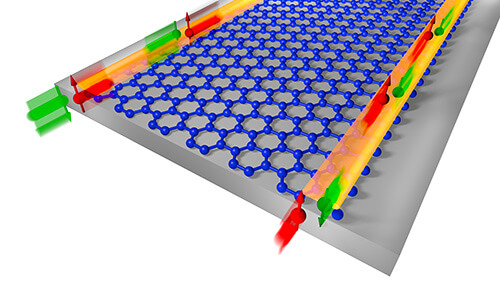
Discoveries in the field of 2-D substances have been exploding. It seems that every few days there is a new breakthrough or application announced by scientists studying these materials. Graphene has been grabbing most of the headlines lately, but researchers at the University of Würzburg in Germany have developed yet another ultra-thin substance.
The material is called bismuthene and is made from a film of bismuth one atom thick atop a silicon carbide substrate. Bismuthene has properties that could lead to advancements in computing and data transmission.
The substance is in a class of materials called 'topological insulators.' Topological insulators have the unique property of being electrically insulating on the inside, but are conductive on the surface due to quantum effects. These materials make suitable data transmitters because of their efficiency in moving electrons. The conductive conduits in the material prevent spin scatter, which reduces electron loss. The only problem is that they usually only work well in temperatures below -270 degrees Celsius. This limitation makes applications in things such as electronics impractical.
Bismuthene has the same properties as other topological insulators except that it can function at room temperature or even higher. When applying the bismuth film to the substrate, the atoms self-form into structurally stable hexagonal bonds. This pattern is the same as we see with sheets of graphene. However, unlike graphene, bismuthene chemically bonds to the silicon carbide.

Render of electron conducting conduits of bismuthene.
“Whereas common bismuth is an electrically conductive metal, the honeycomb monolayer remains a distinct insulator, even at room temperature and far above,” explained Professor Ronny Thomale, one of the researchers working with the substance. Since the material can function at much higher temperatures, it becomes ideal for electronic applications.
The conductive channels of the bismuthene are highly stable and transmit data with extreme efficiency. The scientists at Würzburg have already proven, using microscopic techniques, that the channels in bismuthene can send information with almost no data loss. “Such conduction channels are 'protected topologically.' This means they can be used to transmit information virtually without loss,” said Ralph Claessen, another researcher on the project. “This approach makes data transmission with few electron spins conceivable, the so-called spintronics.”
The breakthrough means that studies in the field of spintronics can advance much faster since supercooling is no longer required to study the quantum effects within the conductive channels. Advanced research in quantum data transmission is still in its infancy, and commercial applications are yet far off. On the plus side, studies in the field have one less barrier slowing its progress.
https://www.techspot.com/news/70058-new-2-d-substance-bismuthene-may-lead-faster.html